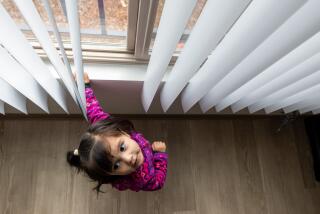Garden Grove : A Temporary Haven for Disabled Opens Officially
- Share via
The state’s first temporary housing facility for disabled homeless people officially opened in Garden Grove on Wednesday, providing not only shelter, but the hope for a new, independent life style as well.
“We provide them with a stop-gap measure so they don’t end up sleeping in a car or in a bus station somewhere,” said Paula Margeson, director of programs at the Dayle McIntosh Center for the Disabled. The ribbon-cutting ceremony Wednesday marked the realization of a dream that began four years ago for Margeson, who was born blind.
For the record:
12:00 a.m. April 6, 1985 For the Record
Los Angeles Times Saturday April 6, 1985 Orange County Edition Metro Part 2 Page 4 Column 1 Metro Desk 2 inches; 39 words Type of Material: Correction
A caption in the March 28 edition of The Times incorrectly reported that the Dale McIntosh Center for the Disabled opened its doors March 27. The center has been in operation for 7 1/2 years. A temporary housing facility known as HEARTH, run by the McIntosh Center, opened March 27.
Amazed by accounts of handicapped people who are left to fend for themselves for months at a time, she became active in a program to provide nightly hotel lodging to the disabled. Of the 3,000 to 4,000 homeless people reported to be living in Orange County, Margeson said that about 15% are disabled.
She soon realized, however, that the service, though it temporarily sheltered 192 people in 1983, was not enough. “I began to think, ‘Hey, we’ve got to find something that’s more long-term. All we’re really doing is putting them up for two to three days. What good are we really solving for them?’ ”
The facility, which will lodge the indigent disabled for up to 30 days at no charge, was the answer. With a combination of county, state and federal funds, the house was bought for $100,000 last year. Since then, about $20,000 in renovations has converted the home into one that is thoroughly accessible to all handicapped people.
Outside, a heavy gray ramp leads to the front door. Inside, a network of ramps connect each of the 10 rooms. Oversized doorways make movement convenient for the wheelchair-ridden, and handrails were installed in the bathroom.
Blinking lights alert deaf guests whenever the phone, doorbell or fire alarm is touched off. Volunteers have helped to provide needed housewares and have spent weekends painting and doing carpentry work.
But the home is much more than a lodging. Guests say it has the power to change their lives.
“They saved my life,” said Libby Tackett, 41, a victim of dyslexia, rickets and arthritis. After months of transiency, she said she was desperate but had nowhere to go. She was referred to the center by the Salvation Army and moved in last week.
“I can’t believe how far I’ve come since Friday,” she said. “I’ve started rehabilitation classes, I have the prospect of an apartment--I can start living again. These people have shown me that I’m not handicapped; I’m handicapable. It’s fantastic!”
The center also has a referral service that tries to find employment for the clients and place them in permanent housing. “So far, we have a 77% success rate,” Margeson said.
Administrators, teachers and the nighttime overseer, who lives permanently at the home, are all handicapped, which Margeson said is an advantage. “When we see people and we tell them that they can be living independently, they see that we are, and they believe it,” she said. “We practice what we preach.”
More to Read
Sign up for Essential California
The most important California stories and recommendations in your inbox every morning.
You may occasionally receive promotional content from the Los Angeles Times.










